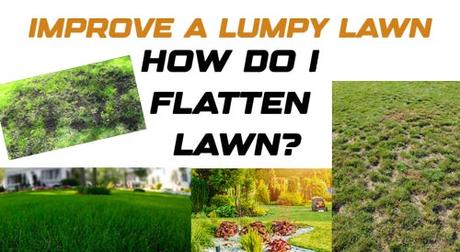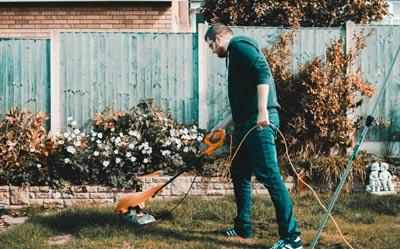Uneven or lumpy lawn is a very common problem faced by lawn owners around the globe. Every lawn and yard that is suffering from this condition must be provided extra care and reparation for the improvement. This problem can be serious if left unchecked and unrepaired.
Here's how you can repair a lumpy lawn and improve its health.

You may be familiar with that nagging question. Chances are, you already have an answer bouncing around in your head. And you're not alone! We all get that itch on our palms when we see a poor, sparsely growing yard.
In fact, it's perfectly normal to fixate on lawns that don't look as good as they should. We all believe we can make a difference, whether by way of injecting some nutrients, tilting the soil with some harsh aeration, or removing rocks and roots. But more often than not, our good intentions lead to frustration over gimmicks that don't work.
How to Improve a Lumpy Lawn?
The real challenge is helping spend-thrift homeowners get quality results without spending too much. And that starts with finding out what's causing the problem so we can avoid making it worse.
Now we'll learn to identify three basic types of lawn problems and come up with a course of action to restore each one back to health. In this installment, let's look at lumpy or bumpy areas in a lawn.
Cause 1: Lawn Care System

I'll go out on a limb and say that most lawn problems have the same root cause: neglect. We've all been guilty of it once in a while, even when we mean well. Perhaps no one is at home in the afternoons to water during hot weather; maybe areas get missed along the side of the house with the most shade; or maybe we're just too busy to feel like stopping what we're doing and moving a sprinkler.
Whatever the reason, one thing's for sure: the grass suffers with no water and will appear thin and weak, and in some cases - as with drought damage - it could die.
Follow this general rule: If grass is thin during the growing season, it most likely needs water. Without adequate soil moisture, grass can't generate new leaves or stems to replace older ones that die. If you want thick, vibrant grass - as we all do - then you need to make sure it gets enough water during the growing season.
So what's the solution for a thin lawn due to drought? You can't be expected to water like crazy, but you should take some steps to get the moisture level back up.
Adding topdressing, or a layer of dirt and organic matter (like peatmoss), will help retain water and bulk up weak soil. When it's dry, simply sprinkle on the topdressing until you've added an inch or so to the entire lawn area. Water in well.
Next, consider either overseeding the lawn with new seed or sodding over thin areas if they're small enough. Overseeding can be done at any time during the growing season; but I like to time it for the end of summer (August and September) when grass growth slows and seeds will settle in more easily.
Sodding is a good choice if you want to make major changes or fill in large areas without re-seeding. Keep in mind that laying sod isn't as easy as it looks, especially if the ground is hard and compacted. It can take a lot of heavy labor to prepare a good seed bed, not to mention the considerable expense of purchasing enough sod.
Check out: Watering hose for your lawn.Cause 2: Soil Compaction

The second leading cause of a "lumpy" lawn is one we can all relate to: poor soil drainage. When water won't drain away from the grass, it sits on the surface and saturates the soil until it becomes compacted. As more water moves in, another saturation layer forms; and as those layers build up over time, the soil compacts into a hard surface that can't be penetrated by water or air.
Grass roots suffocate in compacted soil and eventually die. This allows weeds to move in - which is why you'll see lots of them in lawns with poor drainage - until the entire area turns brown.
Hopefully, you've found this problem before the grass is completely dead. If so, re-wet the lawn and let it dry completely to help draw out some of those saturated soil layers. Next, break up the hardpan with a heavy duty garden fork or a sod cutting tool that can penetrate deep into the ground.
Many areas of compacted soil can be fixed simply by mowing the lawn with a high mower setting and allowing it to grow up taller. The longer grass blades will shade the soil surface from sunlight, which slows evaporation and creates a moister environment. And as they mature, those grass blades will start to fall over three or four weeks - adding organic matter back into the soil as they decompose.
You could also use this time to apply topdressing to build up weak soil, as mentioned above. But if the lawn is so compacted that the grass has died completely, then you'll need professional advice before trying any soil renovation.
Cause 3: Poor Grading

Grading is the process of leveling the ground to provide proper drainage. Poor grading over time creates uneven water flow, which can lead to standing water and erosion - not to mention an uneven playing surface for activities like lawn bowling or croquet.
Leveling soil with good grading is very important in keeping a yard looking its best. One of the most important steps in grading is to make sure that any major changes (building a deck, for example) are done with adequate drainage and soil preparation.
Grading also includes adding or subtracting soil as needed. You'll need to do this if you want to create good drainage away from house foundations, walks and driveways; level out a downslope for a patio, deck or driveway; or even create a slight upslope to allow water runoff away from the yard.
Cause 4: Bad Gardening habits
We've all been there -

using the wrong mower height, cutting grass too short, not watering enough or too much. Each of these practices can make a lawn look lopsided and allow weeds to move in.
The possible causes for uneven lawn surface include; excessive walking/playing of children/pets or other people in lawn especially when soil is wet, using heavy power tools in the lawn for a long duration, frequent mowing of grass, pests invasion (lawn grubs), humid weather situation, and moist soil nature.
- If the lawn is lumpy due to excessive walking of children, or pets, the damage might not be that much serious. Therefore, just the dressing would be required. It can be done by removing the sod layer and raking the lump to make it clean, then fill it evenly with good quality soil or compost, and place the sod layer back. Moreover, you can use sand to fill the wider holes as sand will keep the space intact for longer periods when mixed with the soil.
- If there is clay soil in your lawn, it can be settled by using the aeration technique. Aerating the clay soil will allow the soil to absorb a good amount of nutrients and oxygen deep down to the root system of the grass. Hence, grass will be nourished and stay healthy.
- If the damage is caused due to pests' invasion/infestation, then you must go for the pest killer first. Your problem will be solved by using any good quality killer to eliminate the pests from your lawn. After the removal of pests, follow up with the top dressing and replacing that patch of sod with a new one.
- Avoid frequent and unnecessary mowing your lawn otherwise, you will get so many holes and lumps in your lawn. Scheduling mowing and changing patterns every time is good. Moreover, do not hand over the mowers to the kids as they are notorious, and they might mow some areas too much or some too little, which will cause future problems.
- Using a good fertilizer for your lawn will make the grass healthier, enriched, and thicker that would be enough to cover up all the lumps. Thick grass will also be supported in fighting against diseases and insects that can cause lumps. Remember to get fertilizer that contains high nitrogen content.
Preventive measures:
The best way to prevent the lumpy lawn is to avoid the cause by taking precautionary measures and controlling the problem creators. Furthermore, keep it a little overseeded in humid periods of the year, avoid playing active games like cricket, football, or badminton, keep your pets away from the lawn if they have scrapping habit, use pre-emergent herbicides in your lawn in the early springtime to avoid pest invasion, do not keep heavy furniture in the lawn, and never use a roller to level the lumps.
Hopefully, the above-mentioned techniques would work for all the lawn owners and gardeners. Do not forget to leave your valued response and share techniques if you have ever tried any other than described in the post, and succeeded to recover your lumpy lawn.

